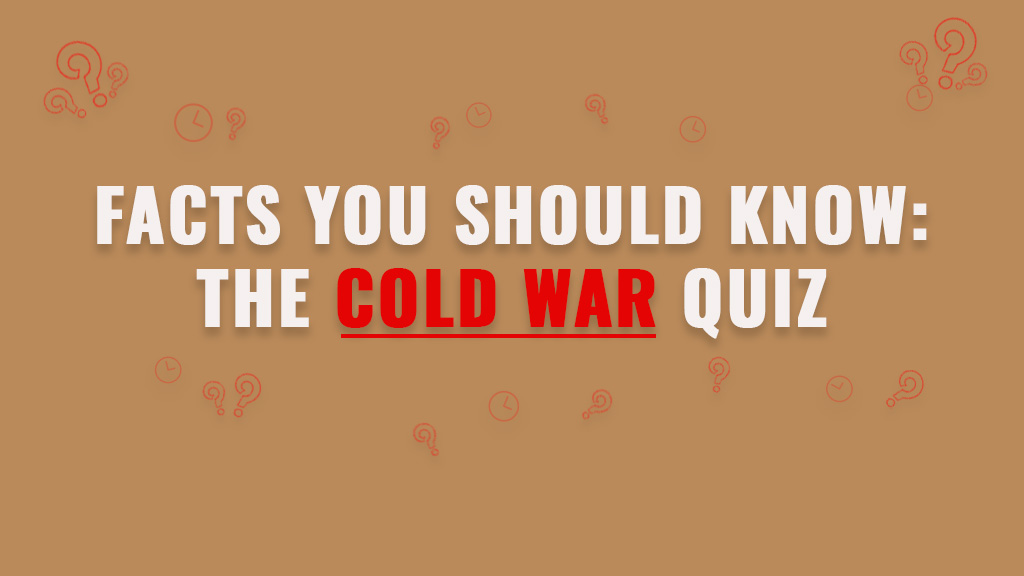❤️It's Trivia, but Sweeter❤️
Facts You Should Know: The Cold War Quiz

Facts You Should Know: The Cold War Quiz:
The Cold War was a period of intense geopolitical tension between two global superpowers: the United States and the Soviet Union. Spanning from the mid-1940s to the early 1990s, it was characterized by ideological conflict, military rivalry, and indirect confrontations, rather than direct military engagement. The Cold War divided much of the world into two opposing blocs, each led by one of these superpowers, with the U.S. representing capitalism and democracy and the Soviet Union representing communism and a one-party totalitarian state.
Following the end of World War II, the power vacuum left by the defeated Axis powers allowed the U.S. and the Soviet Union to emerge as the dominant forces in world politics. However, the ideological differences between these two powers quickly led to a divide. The United States, guided by a belief in democracy and a market-based economy, sought to expand its influence globally, ensuring that capitalism remained the dominant economic system. The Soviet Union, on the other hand, under the leadership of Joseph Stalin and his successors, pursued an agenda of spreading communism and maintaining control over its satellite states in Eastern Europe.
One of the most defining characteristics of the Cold War was the concept of nuclear deterrence. Both the U.S. and the Soviet Union developed vast nuclear arsenals, and the fear of mutually assured destruction (MAD) kept both powers from engaging in direct conflict. Instead, the Cold War was largely fought through proxy wars, espionage, and ideological competition. This resulted in significant events and crises that shaped international relations for decades.
Among the key flashpoints during the Cold War was the Cuban Missile Crisis of 1962. When the Soviet Union installed nuclear missiles in Cuba, just 90 miles off the coast of the United States, the world was on the brink of nuclear war. The U.S. government, led by President John F. Kennedy, demanded the removal of the missiles and imposed a naval blockade around Cuba. After tense negotiations, the Soviet Union, led by Nikita Khrushchev, agreed to withdraw the missiles in exchange for a U.S. promise not to invade Cuba and the secret removal of U.S. missiles from Turkey. The Cuban Missile Crisis highlighted the terrifying proximity of the Cold War to global annihilation and was a defining moment in the tense relationship between the superpowers.
The division of Europe was another major aspect of the Cold War. At the end of World War II, Germany was split into four zones of occupation, each controlled by one of the victorious Allied powers: the U.S., the Soviet Union, Great Britain, and France. Eventually, the ideological differences between the U.S. and the Soviet Union led to the formal division of Germany into two separate states: West Germany, which was democratic and capitalist, and East Germany, which became a communist state under Soviet control. Berlin, the capital of Germany, was similarly divided, even though it lay deep within Soviet-controlled East Germany. In 1961, the Berlin Wall was erected to stop the mass migration of East Germans to the West, further symbolizing the divide between the communist East and the capitalist West.
The formation of military alliances was another central feature of the Cold War. In 1949, the United States and its Western allies formed the North Atlantic Treaty Organization (NATO), a collective defense pact that aimed to prevent the spread of communism in Europe. The Soviet Union responded by establishing the Warsaw Pact in 1955, a military alliance among communist states that sought to counter NATO’s influence. The creation of these alliances solidified the division of Europe and ensured that any conflict between the superpowers would have global repercussions.
The Cold War also saw the proliferation of proxy wars, where the U.S. and the Soviet Union supported opposing sides in conflicts around the world, often in developing nations. One of the most notable examples of this was the Vietnam War, which took place between 1955 and 1975. In Vietnam, the communist North, led by Ho Chi Minh and backed by the Soviet Union and China, fought against the U.S.-supported South, which had a capitalist government. The war resulted in significant loss of life and resources and ended with the fall of Saigon, marking the reunification of Vietnam under communist rule. The U.S. involvement in Vietnam was driven by the belief in the “domino theory,” which held that if one country in a region fell to communism, neighboring countries would follow suit.
The arms race between the U.S. and the Soviet Union was another critical element of the Cold War. Both superpowers invested heavily in the development of nuclear weapons and delivery systems, leading to an ever-growing stockpile of weapons capable of destroying the world multiple times over. The space race, which was closely tied to the arms race, was a manifestation of this rivalry. The Soviet Union achieved the first significant milestone in space exploration with the launch of Sputnik 1 in 1957, followed by the first human spaceflight by Yuri Gagarin in 1961. The U.S. responded by landing the first humans on the Moon in 1969, with the Apollo 11 mission. The space race symbolized not only technological and scientific competition but also the ideological struggle between communism and capitalism.
In addition to military and technological rivalry, the Cold War was also a battle of ideologies. The U.S. promoted liberal democracy and free markets, while the Soviet Union pushed for a one-party system and state-controlled economies. Both sides sought to spread their ideologies around the world through diplomatic efforts, economic aid, and military support for aligned governments. The U.S. pursued containment policies, such as the Marshall Plan, which provided economic assistance to Western European countries to help them rebuild after World War II and prevent the spread of communism. The Soviet Union, on the other hand, supported communist movements and revolutions in Asia, Africa, and Latin America.
By the late 1980s, the Cold War was beginning to show signs of winding down. The Soviet Union was facing significant internal economic and political challenges, and its sphere of influence in Eastern Europe was weakening. Mikhail Gorbachev, the last leader of the Soviet Union, implemented reforms such as perestroika (economic restructuring) and glasnost (political openness), which helped pave the way for greater engagement with the West. The fall of the Berlin Wall in 1989, symbolizing the collapse of communism in Eastern Europe, marked the beginning of the end of the Cold War. In 1991, the Soviet Union officially dissolved, leading to the emergence of multiple independent republics and the definitive end of the Cold War era.
The Cold War had profound effects on the world order, shaping geopolitics, economies, and societies for nearly half a century. It influenced global alliances, military strategies, and technological advancements. The legacy of the Cold War continues to affect international relations today, as the world remains deeply divided by differing political ideologies and the lingering effects of Cold War-era conflicts.



